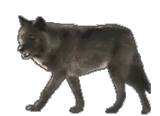|
Great Chiefs In History

Chief Joseph
Nez Pierce (1840-1904)
Chief Joseph, known by his people as In-mut-too-yah-lat-lat (Thunder coming up over the land from the water), was best
known for his resistance to the U.S. Government's attempts to force his tribe onto reservations. The Nez Perce were a peaceful
nation spread from Idaho to Northern Washington. The tribe had maintained good relations with the whites after the Lewis and
Clark expedition. Joseph spent much of his early childhood at a mission maintained by Christian missionaries.
In 1855 Chief Joseph's father, Old Joseph, signed a treaty with the U.S. that allowed his people to retain much of their
traditional lands. In 1863 another treaty was created that severely reduced the amount of land, but Old Joseph maintained
that this second treaty was never agreed to by his people.
A showdown over the second "non-treaty" came after Chief Joseph assumed his role as Chief in 1877. After months
of fighting and forced marches, many of the Nez Perce were sent to a reservation in what is now Oklahoma, where many died
from malaria and starvation.
Chief Joseph tried every possible appeal to the federal authorities to return the Nez Perce to the land of their ancestors.
In 1885, he was sent along with many of his band to a reservation in Washington where, according to the reservation doctor,
he later died of a broken heart.

Geronimo
(juh rah uh moh)
1829 - 1909

Chief Red Cloud
Makhpia-sha
Oglala
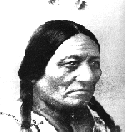
Chief Sitting Bull (Tatanka Iyotake)
Hunkpapa Sioux (1831-1890)
Quotes from Chief Sitting Bull:
"If the Great Spirit had desired me to be a white man he would have made me so in the first place. He put in your
heart certain wishes and plans, and in my heart he put other and different desires. It is not necessary for eagles to be crows."
"I am here by the will of the Great Spirit, and by his will I am chief. I know Great Spirit is looking down upon
me from above, and will hear what I say..."
"The earth has received the embrace of the sun and we shall see the results of that love. He put in your heart certain
wishes and plans; in my heart, he put other different desires.
"In my early days, I was eager to learn and to do things, and therefore I learned quickly. Each man is good in the
sight of the Great Spirit."
"Now that we are poor, we are free. No white man controls our footsteps. If we must die, we die defending our rights."
Trail Of Tears:removal of the cherokee
In one of the saddest episodes of our brief history, men, women, and children were taken from their land, herded into
makeshift forts with minimal facilities and food, then forced to march a thousand miles(Some made part of the trip by boat
in equally horrible conditions). Under the generally indifferent army commanders, human losses for the first groups of Cherokee
removed were extremely high. John Ross made an urgent appeal to Scott, requesting that the general let his people lead the
tribe west. General Scott agreed. Ross organized the Cherokee into smaller groups and let them move separately through the
wilderness so they could forage for food. Although the parties under Ross left in early fall and arrived in Oklahoma during
the brutal winter of 1838-39, he significantly reduced the loss of life among his people. About 4000 Cherokee died as a result
of the removal. The route they traversed and the journey itself became known as "The Trail of Tears" or, as a direct
translation from Cherokee, "The Trail Where They Cried" ("Nunna daul Tsuny").
Ironically, just as the Creeks killed Chief McIntosh for signing the Treaty of Indian Springs, the Cherokee killed Major
Ridge his son and Elias Boudinot for signing the Treaty of New Echota. Chief John Ross who valiantly resisted the forced
removal of the Cherokee, lost his wife Quatie in the march. And so a country formed fifty years earlier on the premise "...that
all men are created equal, and that they are endowed by their Creator with certain unalienable rights, among these the right
to life, liberty and the pursuit of happiness.." brutally closed the curtain on a culture that had done no wrong
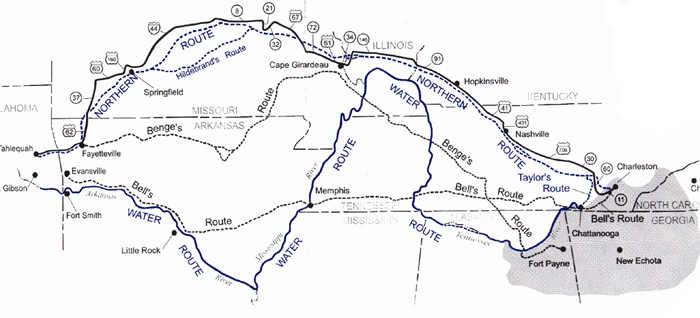
"The Trail Where They Cried"
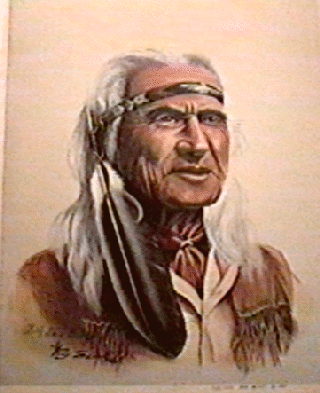
Chief Dan George
(1899 - 1981)
Chief Dan George
"O Great Spirit whose voice I hear in the winds,
I come to you as one of your many children.
I need your strength and your wisdom.
Make me strong not to be superior to my brother,
but to be able to fight my greatest enemy:
"We have taken so much from your culture,
I wish you had taken something from ours...
For there were some beautiful and good things within it.
Perhaps now that the time has come,
We are fearful that what you take will be lost....
I shall grab the instruments of the white man's success:
His education, his skills, and society.
If you talk to the animals they will talk with you and you will know each other.
If you do not talk to them you will not know them, and what you do not know you will fear.
What one fears one destroys."
CHIEF SEATTLE
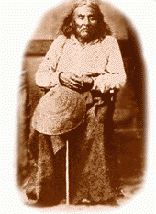
What is man without The Beast?
if all the beast were gone.
Man Would Die From
A Great Loneliness of The Spirit.
For Whatever Happens to The beast
Soon Happens to Man....
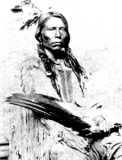
CRAZY HORSE
(Tashunka Witco, Tashunca-Uitco, "his horse is crazy").
TRIBE: Oglala-Brule Sioux.
BIRTH-DEATH: (ca. 1842-1877).
Leader in the Sioux Wars of the 1860s-70s. Nephew of SPOTTED TAIL
Crazy Horse became further known to many of the Sioux bands for his courage in the War for the BOZEMAN Trail of 1866-68
under the Oglala RED CLOUD , when the army began building a road in Powder River country from the Oregon Trail to the goldfields
of Montana.
He was one of the young chiefs, along with the Miniconjou HUMP and the Hunkpapas GALL and RAIN-IN-THE-FACE , who used
decoy tactics against the soldiers.
Near Fort Phil Kearny, Wyoming, Crazy Horse participated in the Indian victories known as the FETTERMAN Fight of December
21, 1866, and the Wagon Box Fight of August 2, 1867.
Geronimo
Geronimo is Spanish for Jerome, applied by the Mexicans as a nickname. His native name Goyathlay, `one who yawns'). A
medicine man and prophet of the Chiricahua Apache who, in the latter part of the 19th century, acquired notoriety through
his opposition to the authorities and by systematic and sensational advertising; born about 1834 at the headwaters of Gila
River, New Mexico, near old Ft Tulerosa. His father was Taklishim,
Cochise
A Chiricahua Apache chief, son and successor of Nachi. Although constantly at feud with the Mexicans, he gave no trouble
to the Americans until after he went, in 1861, under a flag of truce, to the camp of a party of soldiers to deny that his
tribe had abducted a white child. The commanding officer was angered by this and ordered the visiting chiefs seized and bound
because they would not confess. One was killed and four were caught, but Cochise, cutting through the side of a tent, made
his escape with three bullets in his body and immediately began hostilities to avenge his companions, who were hanged by the
Federal troops. The troops were forced to retreat, and white settlements in Arizona were laid waste.
THE BLACKFEET NATION
As the largest and most dominant Indian tribe in Montana, the Blackfeet have played a significant role in the state's
history. Like so many of the Great Plains tribes, the Blackfeet originally lived far to the east in the area north of the
Great Lakes. It is thought they they even ranged as far east as Labrador. Therefore, anthropologists
As the largest and most dominant Indian tribe in Montana, the Blackfeet have played a significant role in the state's
history. Like so many of the Great Plains tribes, the Blackfeet originally lived far to the east in the area north of the
Great Lakes. It is thought they they even ranged as far east as Labrador. Therefore, anthropologists sometimes classify them
in prehistory as one of the eastern woodlands tribes. Like the Cheyenne, Gros Ventre and many others, the Blackfeet are members
of the Algonquin linguistic group.
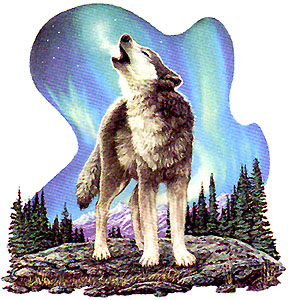
MAKAH Pacific Northwest Tribe:
Welcome to the Makah Nation. We are located on the Olympic Peninsula in Washington State. Our Native American reservation
is in the town of Neah Bay and includes the most northwest point of the continental United States. Across the Strait of Juan
de Fuca you can see Vancouver Island in Canada. Near our village, we have Cape Flattery, Shi Shi, and miles of beach.
You are welcome to explore our little corner of the Internet. This site is a work in progress, so check back often for
updates. Within this site, is a sampling of Northwest Indian culture, including, fishing, the long house and whaling. Soon
there will be pictures of art, including masks. We hope you enjoy your visit
|
